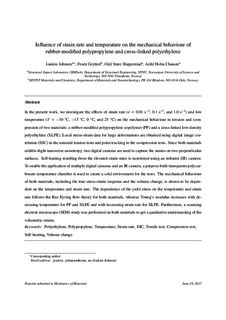| dc.contributor.author | Johnsen, Joakim | |
| dc.contributor.author | Grytten, Frode | |
| dc.contributor.author | Hopperstad, Odd Sture | |
| dc.contributor.author | Clausen, Arild Holm | |
| dc.date.accessioned | 2017-11-21T11:40:14Z | |
| dc.date.available | 2017-11-21T11:40:14Z | |
| dc.date.created | 2017-07-25T19:35:36Z | |
| dc.date.issued | 2017 | |
| dc.identifier.citation | Mechanics of materials (Print). 2017, 114 40-56. | nb_NO |
| dc.identifier.issn | 0167-6636 | |
| dc.identifier.uri | http://hdl.handle.net/11250/2467316 | |
| dc.description.abstract | In the present work, we investigate the effects of strain rate (e˙=0.01 s−1, 0.1 s−1, and 1.0 s−1) and low temperature (T=−30 °C, −15 °C, 0 °C, and 25 °C) on the mechanical behaviour in tension and compression of two materials: a rubber-modified polypropylene copolymer (PP) and a cross-linked low-density polyethylene (XLPE). Local stress-strain data for large deformations are obtained using digital image correlation (DIC) in the uniaxial tension tests and point tracking in the compression tests. Since both materials exhibit slight transverse anisotropy, two digital cameras are used to capture the strains on two perpendicular surfaces. Self-heating resulting from the elevated strain rates is monitored using an infrared (IR) camera. To enable the application of multiple digital cameras and an IR camera, a purpose-built transparent polycarbonate temperature chamber is used to create a cold environment for the tests. The mechanical behaviour of both materials, including the true stress-strain response and the volume change, is shown to be dependent on the temperature and strain rate. The dependence of the yield stress on the temperature and strain rate follows the Ree-Eyring flow theory for both materials, whereas Young’s modulus increases with decreasing temperature for PP and XLPE and with increasing strain rate for XLPE. Furthermore, a scanning electron microscope (SEM) study was performed on both materials to get a qualitative understanding of the volumetric strains. | nb_NO |
| dc.language.iso | eng | nb_NO |
| dc.publisher | Elsevier | nb_NO |
| dc.rights | Attribution-NonCommercial-NoDerivatives 4.0 Internasjonal | * |
| dc.rights.uri | http://creativecommons.org/licenses/by-nc-nd/4.0/deed.no | * |
| dc.title | Influence of strain rate and temperature on the mechanical behaviour of rubber-modified polypropylene and cross-linked polyethylene | nb_NO |
| dc.type | Journal article | nb_NO |
| dc.type | Peer reviewed | nb_NO |
| dc.description.version | acceptedVersion | nb_NO |
| dc.source.pagenumber | 40-56 | nb_NO |
| dc.source.volume | 114 | nb_NO |
| dc.source.journal | Mechanics of materials (Print) | nb_NO |
| dc.identifier.doi | 10.1016/j.mechmat.2017.07.003 | |
| dc.identifier.cristin | 1483084 | |
| dc.description.localcode | © 2017. This is the authors’ accepted and refereed manuscript to the article. LOCKED until 6.7.2019 due to copyright restrictions. This manuscript version is made available under the CC-BY-NC-ND 4.0 license http://creativecommons.org/licenses/by-nc-nd/4.0/ | nb_NO |
| cristin.unitcode | 194,64,45,0 | |
| cristin.unitname | Institutt for konstruksjonsteknikk | |
| cristin.ispublished | true | |
| cristin.fulltext | postprint | |
| cristin.qualitycode | 1 | |

